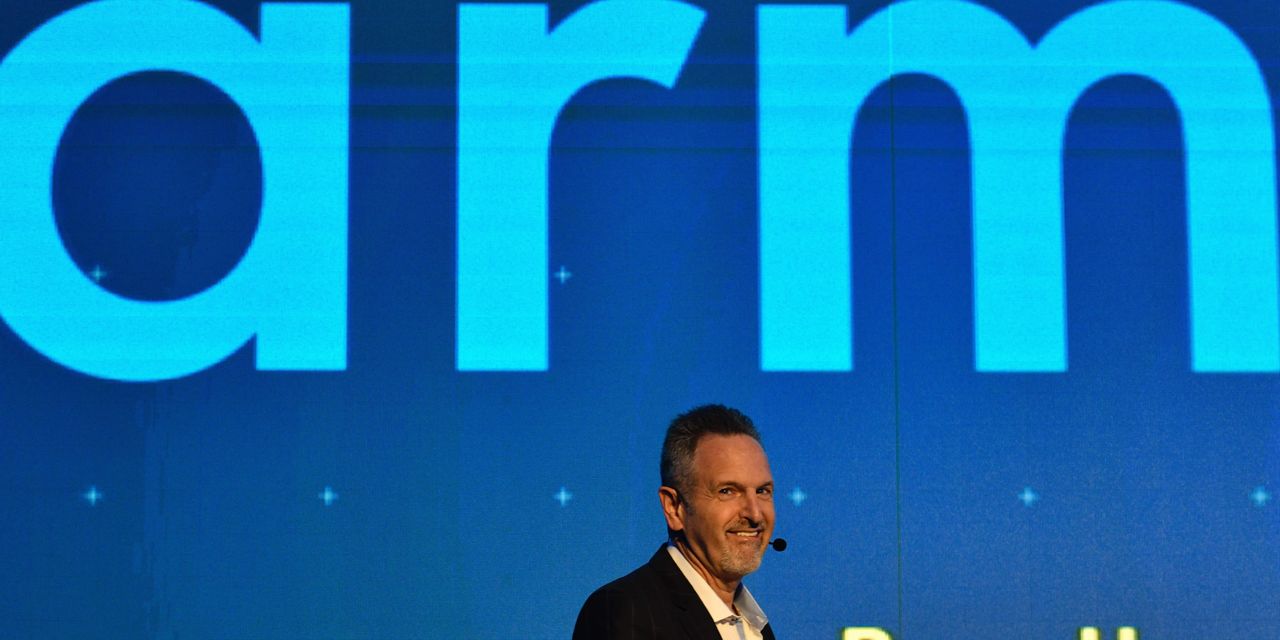Arm Holdings Ltd. filed its long-awaited initial public offering late Monday, following last year’s failed bid by Nvidia Corp. to acquire the U.K.-based chip architecture company.
Arm has reportedly been seeking to raise $8 billion to $10 billion at a valuation of $60 billion to $70 billion, which would make its IPO the biggest of the year so far, and a number of large tech companies, including Amazon.com Inc.
AMZN,
Intel Corp.
INTC,
and Nvidia
NVDA,
are reportedly in the mix to be anchor investors.
In a late Monday filing with the Securities and Exchange Commission, Arm said it was offering to list its U.S. traded shares on the Nasdaq under the ticker symbol “ARM.”
Arm, which is owned by Japan’s SoftBank Group Corp.
9984,
was the target of an unsuccessful $40 billion acquisition by Nvidia last year. After Nvidia scrubbed the deal and paid a $1.36 billion breakup charge following the U.S. Federal Trade Commission’s unanimous decision to block it, Nvidia disclosed it paid Arm $750 million for a 20-year license to its technology.
At the time of the breakup, chips sales had hit record highs in 2021, surging 26.2% to a record $555.9 billion, fueled by pandemic-triggered shortages. But the chip industry has since swung to a glut.
Arm listed Barclays, Goldman Sachs, JP Morgan, Mizuho, BofA Securities, Citigroup, and Deutsche Bank Securities among the IPO’s underwriters.
Recent reports said SoftBank was in discussions to purchase the 25% stake in Arm that it does not outright own, which is held by its Vision Fund 1, ahead of the IPO.
Read from Feb. 2022: Wall Street’s reaction to death of Nvidia-Arm deal: No duh
Arm reported net income of $524 million, or 51 cents a share, on revenue of $2.68 billion for fiscal 2023, which ended March 31, compared with net income of $549 million, or 54 cents a share, on revenue of $2.7 billion, in fiscal 2022, and $388 million, or 38 cents a share, on revenue of $2.03 billion in fiscal 2021.
Arm uses an architecture that is different from the once-standard x86 one built by Intel in the early days of computing.
The company said it has shipped more than 250 billion Arm-based chips since it started in 1990 as a joint venture between Acorn Computers, Apple
AAPL,
and VLSI Technology. In fiscal 2023, Arm said it shipped 30.6 billion chips.
The company said it is going public as the “resources required to develop leading-edge products are significant and continue to increase exponentially as manufacturing process nodes shrink.” Transistors are expressed in scales of nanometers, with design costs running about $249 million for a 7-nanometer chip and about $725 million for a 2-nm chip.
In fact, a little less than a year ago, Nvidia founder and Chief Executive Jensen Huang underscored just how much costs had shot up, when critics complained about higher-then-expected prices for the company’s new round of gaming chips. “A 12-inch [silicon] wafer is a lot more expensive today than it was yesterday, and it’s not a little bit more expensive, it is a ton more expensive,” Huang said.
But that was before Nov. 30, when Microsoft Corp.
MSFT,
-backed OpenAI released its generative AI ChatGPT into the wild, triggering a wave of excitement for a technology that luminaries have compared with tech’s greatest achievements.
“As the world moves increasingly towards AI- and [machine language]-enabled computing, Arm will be central to this transition,” the company said in the filing. “Arm CPUs already run AI and ML workloads in billions of devices, including smartphones, cameras, digital TVs, cars and cloud data centers.”
Arm said it is working with Alphabet Inc.
GOOG,
GOOGL,
GM’s
GM,
Cruise, Mercedes-Benz
MBG,
Meta Platforms Inc.
META,
and Nvidia “to deploy Arm technology to run AI workloads.”
Following the filing, Pitchbook venture-capital analyst Kyle Stanford said in emailed comments that Arm was “certainly an intriguing IPO from several different perspectives.”
“VC-backed tech listings will surely look at the pricing performance of the IPO, but there aren’t as many parallels between Arm and the typical VC-backed unicorn as the market likely hopes,” Stanford said. “Arm is riding the AI wave, but it is also reportedly profitable, which continues to be a large point of emphasis for the market.”
Read: VC spending is in a tailspin, and AI can’t reverse the trend — yet
Read the full article here



